#Augustan Period
Text

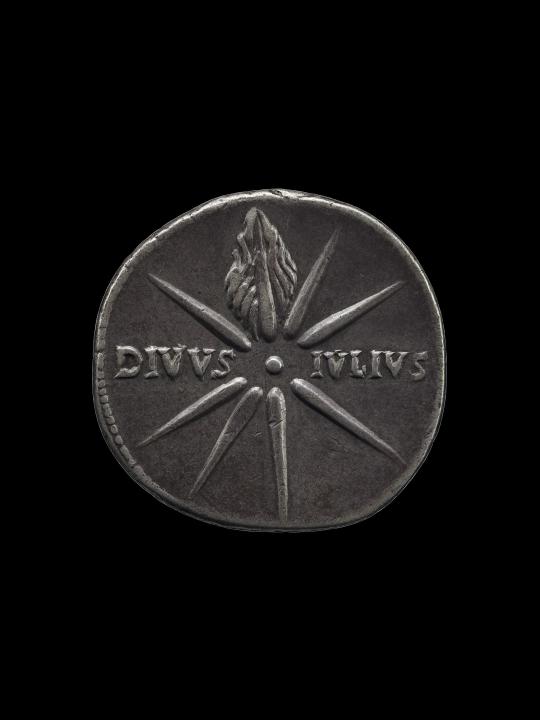
Denarius with head of Augustus wearing oak wreath (obverse) and comet with eight rays and inscription Divus Julius (reverse)
Roman (possibly minted at Caesaraugusta, modern Zaragoza in Spain), Imperial Period, 19-18 B.C.
silver
British Museum
#I love the coins of Augustus with representations of Caesar's Comet#I linked to the Wikipedia page if you want more info#denarius#Augustus#Julius Caesar#Caesar#Caesar's Comet#Divus Julius#Roman Empire#Augustan Period#Imperial Period#silver#coin#numismatics#British Museum
176 notes
·
View notes
Text

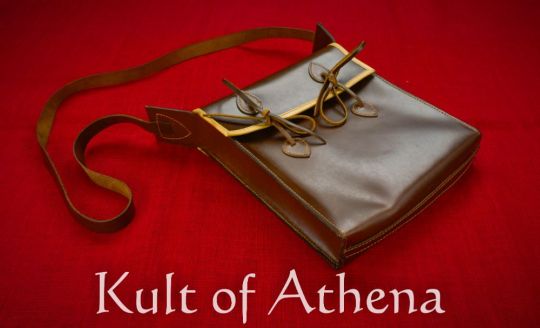

Deepeeka – Roman “Comacchio” Leather Bag
This Roman Leather Bag is named after the Augustan Period Roman “Camacchio” shipwreck which yielded a remarkably well preserved Roman military leather bag among a wealth of other artifacts. An expansive Roman bag such as this was necessary to carry much of the gear needed by the well-equipped Roman Legionary. This reproduction is crafted from high quality genuine leather with sturdily stitched construction. Its flap is sealed with a pair of tie closures and is finished with a shoulder strap for easy wear.
#Kult of Athena#KultOfAthena#New Item Wednesday#Deepeeka#Roman “Comacchio” Leather Bag#Comacchio Leather Bag#Leather Bag#Leather Goods#Bags#Bags & Pouches#Accessories#New Item#New Items#Camacchio#Camacchio Shipwreck#Augustan Period#Roman Legionary#Roman Accessories
3 notes
·
View notes
Photo

Marble oscillum with relief of a satyr collecting bunches of grapes - Augustan period, 29 BC - 19 AD
National Archaeological Museum of Athens.
#Marble oscillum with relief of a satyr collecting bunches of grapes - Augustan period 29 BC - 19 AD#archeology#archeolgst#ancient artifacts#history#history news#ancient history#ancient culture#ancient civilizations#ancient greece#greek history
12 notes
·
View notes
Text
"There is one injury of yours that must be amended. You said that you felt alone. Never here. Not while I draw breath, you will never know a lonely day again." FUCK THE ROMAAANCE !
#just finished d.imension 20's a c.ourt of f.ey and f.lowers and I keep thinking about one of the pc couples#they were super sweet#great campaign full of like augustan period court romance and fey fuckery highly recommend it it's also pretty light on dnd mechanics
2 notes
·
View notes
Text
Found the courage to ask for tips in a Facebook reenactment group. Baroque fest, next year I'll be there :D
#personal#Listen you'll visit one lecture about the augustan age by a decent prof and it'll be over for you#It's such an underrated interesting time period
5 notes
·
View notes
Text

Beautiful Roman fresco of the Augustan period, found in the gardens of the Villa Farnesina on the south bank of the river Tiber.
Photographed by Sam Florio (2019)
Although there is no certainty, it is believed that the owner of the house was Marcus Vipsanius Agrippa, since the style and quality of the fresco are similar to those of the house of Augustus on the Palatine.
257 notes
·
View notes
Text


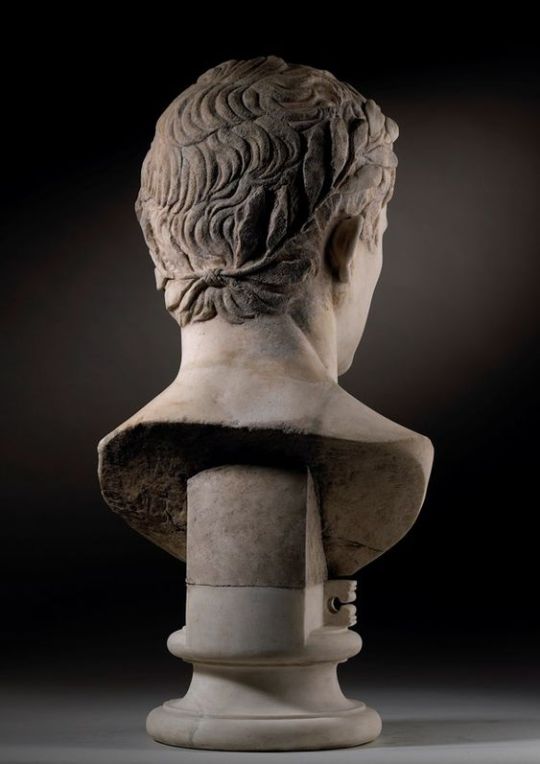
The marble bust of Augustus wearing a laurel wreath, of unknown provenance but most likely contemporary to the Augustan period, now a part of a private collection in the UK.
#augustus#marble bust#emperor augustus#caesar augustus#bust#ancient rome#roman empire#ancient art#roman art#i wonder how many of these treasures are locked behind closed door where only greedy people can appreciate it
59 notes
·
View notes
Text
Me: Oh yeah? Well could an autistic person do this?!
Me: Delivers an unprompted 45 minute seminar on the political, philosophical and poetic significance of bees in ancient literature with a special emphasise on their significance in Rome during the period from the death of Caesar to early Augustan Rome - pausing to point out how contentious the term “Augustan” is in this context.
My Friends: Yeah…yeah, I’m pretty sure like only autistic people can do that buddy.
#neurodivergent#neurodiversity#its the neurodivergency#neurospicy#autism#autistic things#late diagnosed autistic#autistic experiences
80 notes
·
View notes
Text
Limits of Propaganda in the Augustan Regime
I saw a neat post earlier about how Augustus used propaganda to justify his control of Rome and establish permanent one-man rule. It got me thinking about what we picture when we say "propaganda," how Roman propaganda differed from modern propaganda, and how we talk about the interactions between governments and their people.
Augustus' cult of personality has some parallels with monarchist propaganda in early modern Europe, and with authoritarian governments today. But there were also major differences that I think we need to remember, or else we may wrongly project modern assumptions onto the past. In particular, I think the predominance, effectiveness, and superficiality of Augustan propaganda are often overstated. And I think this distortion reinforces a classist bias in our perception of the people of Rome, a bias that contributes to the erasure of ordinary people's contributions to history.
This isn't a formal essay, and I'm not a historian. I may have misremembered some things. But, if you'd like to hear me ramble...
How powerful was Augustan propaganda in shaping people's views of the government?
The word "propaganda" was popularized in the 20th century, in association with mass communication. Modern governments can ensure their propaganda is seen by millions of people at once, and restrict access to opposing viewpoints. Massive amounts of money, equipment, and professional teams are employed to spread these messages.
The only mass media in Augustan Rome were coins, which Augustus could only put very limited text and images on. He erected numerous monuments, but those are limited to a few paragraphs at most, and only to the people who visit them. He could patronize writers and poets like Livy and Vergil, but even they lacked the reach of television, radio or the internet. And all of these methods would have been far more expensive than the mass media of today.
Augustus' propaganda wasn't novel. Roman leaders had been stamping their messages onto coins, monuments, writing memoirs and hiring poets for centuries. Throughout his reign people still would have seen coins and monuments from the republican period, and read the works of Cicero, Brutus, and other republican leaders. In the same way most people today have learned not to trust everything they see on TV, most Romans would have known not to believe everything they saw on monuments, coins, or in state pronouncements.
Nor was Augustus able to limit the spread of contrary narratives like modern dictators can. The Roman government was extremely barebones by today's standards, lacking the bureaucracy and resources to surveil the population. Most Romans didn't get their news from public announcements, state-sponsored art, or politicians' books, but from gossip, letters, and their own information networks.
Over half of all male Romans traveled abroad at some point in this period (Mary Beard, SPQR, ch. 5). They had many different viewpoints available, and other sources of information about what was happening in the provinces. Augustus thus could only bend the narrative to his benefit so far. When several legions were annihilated in Teutoburg Forest in 9 CE, he didn't even try to cover it up; people would've called him on it.
Augustus had more control over how he presented himself and his family to the public than over the narrative of tangible events in the world. Thus most of his propaganda either focuses on shaping his image of himself, his family, or on the personal character of Antony and Cleopatra instead of events Romans could verify or disprove.
But he couldn't stop information from leaking, family scandals from happening, or rumors from spreading. He exiled his daughter Julia, in part for her extramarital affairs, but also because the notoriety of the scandal undermined the squeaky-clean "Roman family values" image he intended for his family to present. When he sent Agrippa to govern the eastern provinces, rumors abounded that some rift had formed between the two. Whether or not such a rift actually happened, the fact that the rumor existed, and survived for 150 years into Suetonius' era, shows how limited Augustus' control of public perception actually was.
How independent were Roman citizens, soldiers, and senators?
These are three very distinct groups that behaved in different ways. Let's start with the general public.
The Roman People
The evidence is clear: we know people organized public protests and petitions throughout Augustus' reign, and even spoiled elections sometimes by voting for the "wrong" candidates.
A group of women took over the forum to protest his tax hike in 42 BCE, despite a wave of proscriptions. He was nearly stoned to death by an angry mob in 39 BCE. The Romans repeatedly petitioned for Julia's freedom, and as late as 9 CE we hear of protests against his marriage laws.
Why did the public express themselves so freely? Well, for one thing, Augustus chose not to suppress popular demonstrations. In fact, he seems to have used the semblance of "free speech" as a tool to deflect accusations of tyranny. By cultivating an image of himself as a moderate who permitted public dissent, he made his political dominance appear less authoritarian and more palatable to the people of Rome.
Augustus probably also thought it was impossible to control what people said, so didn't bother to try. In one of his letters to Tiberius, Augustus says as much:

Suetonius, Augustus, 51
Another big factor was that many public protests tried to persuade him to take on more power. They repeatedly demanded that he take up the dictatorship, or tried to elect him consul when he wasn't running. And no, this doesn't seem to have been the "fake elections" you see in modern dictatorships. The reason is that people's trust in the Senate's competence had collapsed, so when national crises arose like famines, plagues, or debt problems, they tried to make Augustus take back the reins, instead of sharing the power with the Senate as he pretended he was doing.
Which brings us to Augustus' bizarre relationship the Senate.
The Senatorial Class
How independent were the senators? Suetonius gives us a raucous picture:

Augustus also reintroduced competitive elections. Not free, really - everyone knew Augustus' power far outweighed the consuls and praetors. But we do have records of candidates attempting to bribe voters and slinging accusations at their opponents, similar to republican times. This was another way that Augustus tried to distance himself from the dictatorships of Caesar and Sulla, and make his authority palatable to people who valued republican liberty.
He also collaborated with senators behind the scenes, and selected some of them as advisors and proxies for introducing legislation. Augustus' rule was negotiated in a series of settlements, public and private, with the same class of people who had killed Julius Caesar for threatening their place in the public order.
Augustus needed the aristocracy's skills, education, and resources to administer the empire. He also needed to placate them enough to avoid getting the Ides of March Special. They, in turn, needed a way to maintain their dignitas and roles in government, which had traditionally been conferred by elections. By permitting elections, incorporating senators into policy-making behind the scenes, and giving them the outward appearance and status of their old authority, Augustus satisfied them enough to stabilize his rule.
However, the value of elections, and of being in the Senate, clearly declined over time. In the second half of his reign senatorial attendance declined so sharply Augustus introduced penalties for senators not showing up to "work." Eventually elections for the high magistracies were phased out, and the Senate was allowed to elect consuls from among themselves. This was actually popular with senators, since it spared them the expense of campaigning.
And although Augustus did permit senators' input into his government, his control steadily increased over time. Part of this was official, as re-settlements granted him additional powers. And part of it was de facto, as he simply outlived everyone who had experience managing the government. Augustus' longevity, experience, and informal network of advisors effectively made his household the hub of government policy. (His nepotistic habit of giving his relatives the most important jobs also contributed.) Meanwhile, the Senate had a sort of "brain drain" effect as a new generation of senators grew up without the experience of running the state themselves.
By the ascension of Tiberius in 14 CE, senatorial autonomy was dead. Even when Tiberius attempted to step back from government and encouraged the senators to state their own opinions, this only resulted in paralysis. He could not replicate the personal, unofficial relationships Augustus had developed to govern without appearing "tyrannical," and tension between the Senate and emperors would plague Rome for another 200 years.
The Military
Although Augustus took pains to disguise it, we should never forget that he was a military dictator. His power came first and foremost from the loyalty of the army, and their loyalty depended on getting paid. The last great threat to his rule wasn't Antony or Cleopatra, but a huge mutiny in Italy after the Battle of Actium. If he hadn't annexed Egypt and distributed its riches to his troops, there's a high chance he would have been overthrown.
Augustus also needed to convince the legions and public of his military ability, and thus that Rome was safe under his rule. He was not a gifted commander, but he was usually good at selecting them, most notably in Marcus Agrippa, Drusus, Tiberius, and Germanicus. On the other hand, the catastrophic loss of several legions in Teutoburg Forest seriously frightened him. He feared a loss of public confidence, and thus rebellions and political rivals, and quickly sent Drusus and Tiberius with their armies to retaliate.
Augustus established a permanent army to guard the entire empire, which strained the empire's budget to its limit. He managed to pay for it all, barely. Later emperors would repeatedly run into mutinies and even be overthrown by troops who weren't satisfied with their wages.
Augustus' reign was a difficult balancing act between the needs of many competing interest groups, especially early on. After multiple civil wars, the state was poor, the people were exhausted and traumatized, the Senate and citizens feared each other, Romans opposed provincials, soldiers opposed civilians - it was a mess. It's hard to describe the damage to Rome's social and economic infrastructure.
Perhaps the greatest achievement of Augustus' reign was that he managed to navigate between all of these groups, get each of them to trust him to look out for their interests, and gave Roman society enough time to knit itself back together. To win that trust, he couldn't rely on bribes and propaganda alone. He had to prove it through action.
Augustan propaganda had to be justified through tangible benefits, not mere words and imagery.
The word "propaganda" is usually used to refer to rhetoric, advertisements, and manipulation. It connotes hollowness and subterfuge. But Augustus did not trick people into liking him by just hiring the right poets and erecting statues. His most effective propaganda was demonstrated through public renovations and the assurance of public order.
The bar wasn't high to clear. We have to remember that Augustus wasn't a dictator replacing a functioning republic; he was introducing a stable government with competitive (but not free) elections after 20 years of civil war, and another ten years of political violence before that. Peace alone was a major reason why people accepted his rule.
The quality of life for both Romans and provincials mostly improved during his reign, too. From Marcus Agrippa fixing the sewer system and providing the entire city with clean water, to Rome's first permanent fire brigade, to increased economic mobility, to safer long-distance travel, to stabilizing the grain supply, even down to individual tax disputes and court cases Augustus encountered while touring the provinces. The Romans would also have seen Augustus' military victories as a form of public service, a way of enriching the empire and restoring national pride. (And they were officially his victories, since he remained the commanding officer, even if the campaigns were masterminded by Agrippa or another subordinate.)
I think that history books sometimes frame Augustan propaganda as a sort of trick to make the populace accept one-man rule. But you can't really separate the effects of his propaganda from his demonstrable actions that most Romans approved of. The Romans were not simpletons, and they weren't afraid to express their anger with him violently. (Even with the Praetorian Guard present: a mob attacked him and his soldiers in 39 BCE.) Augustus was testing out a fragile and experimental form of government, and had give people results.
That said, we should not attribute the benefits of Augustus' rule to autocracy. We certainly shouldn't use it to justify authoritarianism, as many fascists have attempted. Augustus' government was better than an ongoing civil war; that does not mean it was better than a democracy. And the downsides of autocracy rapidly took effect after his death: first in Tiberius, who initiated the first purges since 42 BCE; then with Caligula, who was...well, Caligula.
If anything, I think Augustus' reign shows how goddamn hard it is to kill people's desire for liberty and their voice in government. If we overlook the protests, the riots, and the constant need for the princeps to justify his regime with military and domestic success, then we erase the input of the common people. And that contributes to a classist view of history in which only rich, powerful men can make meaningful contributions.
Augustus used propaganda, absolutely. But the Roman people were not satisfied with pretty words and images. They paid attention to what the state was doing, they expected it to serve, feed, and protect them, and they even intervened in issues like Julia's exile that didn't personally affect them.
Perhaps we should give them a little more credit.
Further Reading/Watching
Mary Beard, SPQR
Anthony Everitt: Augustus: The Life of Rome's First Emperor
Adrian Goldsworthy, Augustus: First Emperor of Rome
Erich Gruen, The Last Generation of the Roman Republic
Robin Seager, Tiberius
Historia Civilis (YouTube channel)
#jlrrt speaks#octavian#propaganda#hot takes with jlrrt#once again i'm not a historian this is all just my opinion#i would totally stuff augustus into a locker and then run like hell before agrippa could catch me#jlrrt essays
63 notes
·
View notes
Text

~ Marble relief with Hermes.
Period: Augustan or Julio-Claudian
Date: 27 B.C.–A.D. 68
Culture: Roman
Medium: Marble
#ancient#ancient art#history#museum#archeology#ancient sculpture#ancient history#roman#ancient roman#marble relief#hermes#marble#relief#Augustan#julio-claudian#27 b.c.#a.d. 68
806 notes
·
View notes
Text





Gennai Hiraga.

Of all the name-droppings the series has been doing, so far they do it exceptionally well when it comes to Japanese folklore and historical personages.
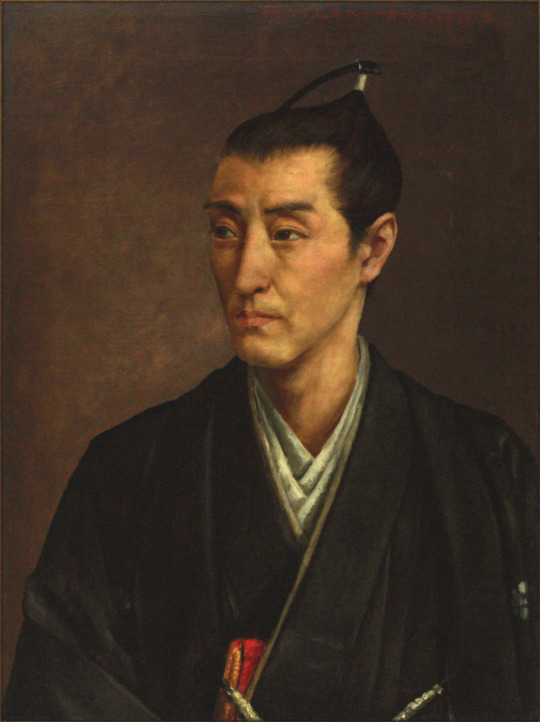
Hiraga was a real person. Now, what’s so interesting about him is that not only he came from a low-ranking samurai family during the Edo Period, he was also a polymath, a rōnin (wandering samurai) a doctor, a pharmacologist, an inventor. Most of all, he was purported to be a homosexual. He frequented the brothels that showcased male prostitutes.
Hiraga (1726-1779) was a prominent Rangakusha (scholar of "Dutch"-i.e., European-learning) and botanist who conducted experiments with asbestos and electricity. He was also one of the most popular writers of the late Tokugawa period and a regular patron of the male brothels referred to as kodomo-ya. His friend, the leading scholar Ota Nanpo, recorded that "when [Gennai] had money, he hurried to spend it in Yoshicho on the pleasure-boys. There he would spend days at a time, and that is why he glorified nanshoku in Nenashigusa.
He was also a writer, a satirist to be exact. He also wrote guidebooks on the male prostitution in Japan.
Those who like female prostitutes dislike youths; those who like youths revile female prostitutes. — Hiraga Gennai, “San no asa” (1768)
…
Gennai himself, according to Ota Nanpo, often visited Yoshicho and the "southern wards" of Edo, with their nanshoku teahouses, but never went to Yoshiwara, with its female prostitutes. His biographers claim the scholar was not simply a shudo-zuki but an onna-girai, or "woman-hater."' Men identified as such, like similar characters in Ming-Qing or even in English Augustan literature, find any contact with the female sex revolting.
…
For the benefit of such culturally deprived men, Gennai lightheartedly describes the nanshoku-jaya experience, including its thrills and frustrations: “Stroking his patron's arm, [a male prostitute] will strike a dreamlike pose, as though he is himself reaching heights of ecstasy. He'll make endless, capricious vows,i and address you with the most intimate names. [Tears] will appear about the eyes on his dazzled face. Aara, that's strange! Is this some apparition? A group [sent from] his manager!k Yai! Those of you who love sweets might find this amusing. But don't laugh. It'd be the gravest mistake not to eat up all those crumbs. You might start taking a liking to wine!”
One of his works dealt with farting and a story about a Kappa “that tries to seduce the actor and then attempts to drown them, in order to complete their task. In the end the Kappa ends up falling for the young actor and instead brings back a less attractive Onnagata as a consolation prize.”
Kappa is a type of a water sprite in Japanese folklore.
Mischievous by nature, they loudly pass gas in public and love to peek up women’s kimonos. Sometimes their mischief turns violent. Kappa have been known to kidnap or rape swimming women, and kill people. A kappa’s preferred method of attack is to drown its victims, or bite them to death under water. Kappa also devour humans alive. Usually they go for the rear end to get at the shirikodama, a mythical ball of flesh located just inside the anus.
Anyway, Gennai Hiraga is indeed an interesting person. The episode tied him up nicely emphasising his Jack of all trades-esque personality.
Source: “Male Colors: The Construction of Homosexuality in Tokugawa Japan,” Gary P. Leupp
#undead girl murder farce#undead murder farce#aya rindo#tsugaru shinuchi#shizuku hasei#episode 9#werewolves#gennai hiraga#ugmf spoilers
43 notes
·
View notes
Text
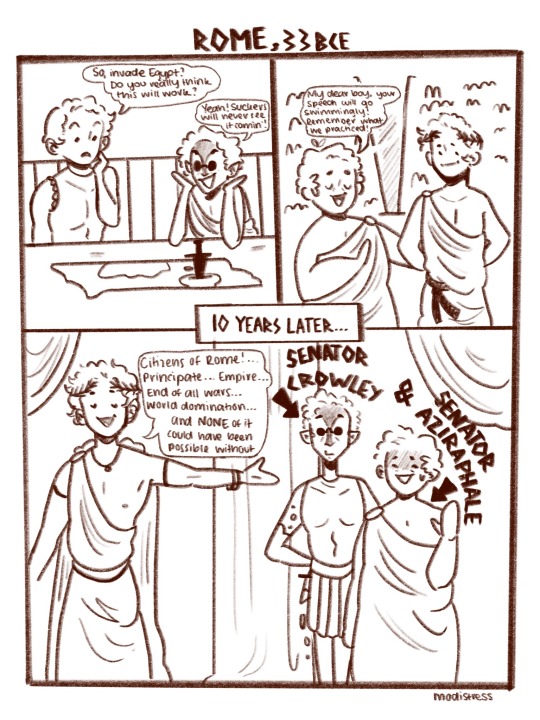
Combining ineffable husbands and my favourite historical period… AUGUSTAN AGE!
(They may or may not have accidentally started the first dictatorship)
#aziracrow#aziraphale#crowley#crowley and aziraphale#good omens#good omens 2#ineffable husbands#crowziraphale#neil gaiman#augustan age#emperor Augustus#ineffable husbands on a journey through time#Crowley X aziraphale#good omens fanart#good omens art#ancient history#artist#artists on tumblr
50 notes
·
View notes
Text
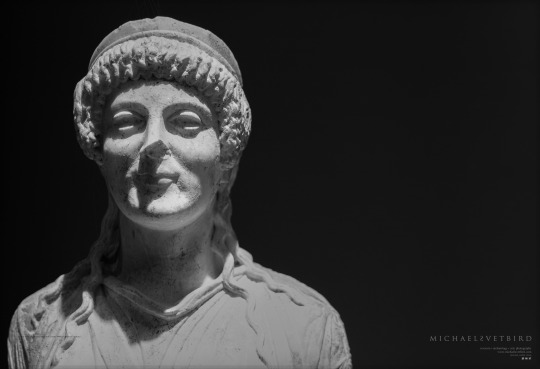

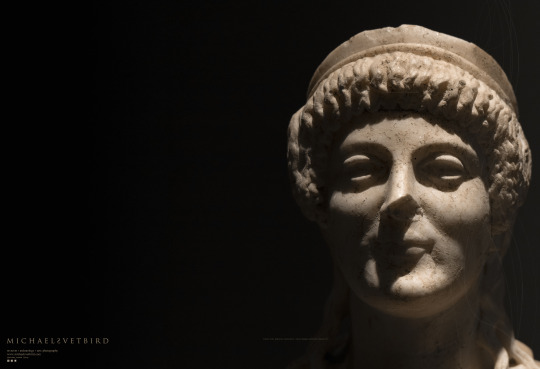
ARTEMIS Type Naples:
"The Goddess of the hunt is shown advancing rapidly, her quiver slung around her body.
With her left hand she lifted an edge of her dress, whilst in her right she held a bow and arrows.
Statue in the archaizing style of the early Imperial period, also known from other examples.
Augustan Period [early 1st cent. AD]."
[txt ©MNR Palazzo Massimo]
White fine-grained greek marble with traces of red paint on the robe, inserted eyeballs were made of different material.
Probable provenance - residential building [Caserta, Campania ?], was stolen [1994] from the area of Caserta, recovered [2001] in Switzerland.
1 AD.
Palazzo Massimo, Museo Nazionale Romano | MNR PM
[2nd Floor, Sala VIII.]
• Web : https://museonazionaleromano.beniculturali.it/en/palazzo-massimo
• FB : https://www.facebook.com/MNRomano
• IG : @museonazionaleromano
• TW : @MNR_museo
MNR PM | Michael Svetbird phs©msp | 06|23 6000X4100 600 [Set of 3]
The photographed object is the collection item of MNR PM and subject to copyrights.
[non commercial use | sorry for the watermarks]
📸 Part of the "Small Format Sculpture and Miniature Artefacts" MSP Online Photo-gallery:
👉 D-ART:
https://www.deviantart.com/svetbird1234/gallery/69450077/small-format-sculpture-and-miniature-artifacts
👉 FB Album:
https://www.facebook.com/media/set/?set=a.859777984390780&type=3
.
#rome#roman#palazzomassimo#museonazionaleromano#massimo#ancient sculpture#sculpture#artemis#άρτεμις#artemide#artemida#goddess#antiquity#antiquities#archaeology#archeologia#ancient#culture#ancientworld#museology#museum#mythology#heritage#art history#archaeology art#photography#archaeology photography#sculpture photography#museum photography#michaelsvetbird
35 notes
·
View notes
Note
hi tate, do you have any recommendations for learning more about augustus and the augustan period? i'm doing some research on it and i'm a bit lost on where to start. thanks!
hi! augustan rome by andrew wallace-hadrill is a v. good (and short!) introduction to / overview of the period, and also includes suggestions for further reading. then the cambridge companion to the age of augustus is good for starting to go into more detail on specific subjects within augustan rome. it's a lot longer though so i wouldn't recommend just sitting down and reading the whole thing (i did this) (but why would you). it also has a good timeline + each chapter is followed by further reading on that subject :-)
16 notes
·
View notes
Photo
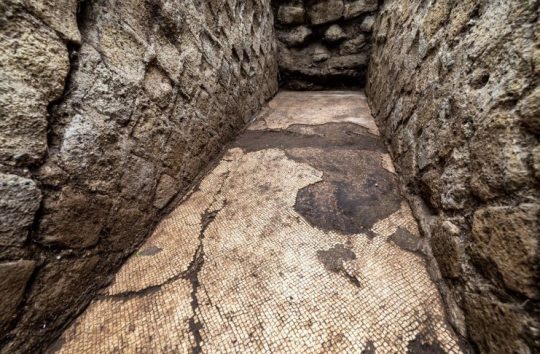
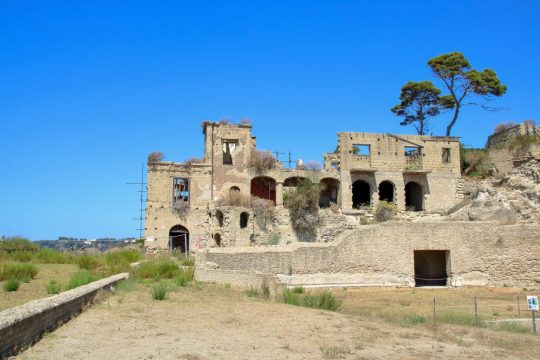
Archaeologists uncover ancient mosaic of the living room of brutal Publius Vedius Pollio
In the Pausilypon Archaeological Park, archaeologists from the University of Naples’ “L’Orientale” uncovered an ancient mosaic.
The park is located in Posillipo, which was an elite quarter of Naples in modern-day Italy during the Roman period. The park is accessible via the 770-meter-long “Grotta Seiano” tunnel, which was excavated during the Roman period. This park consists of ancient structures that face the sea but actually extend far below the sea’s surface. In fact, the Pausilypon Archaeological-Environmental Park shares boundaries with the Gaiola Sunken Park.
Pausilypo (“Pausilypon” in ancient Greek means “relieving from pain”) was a luxurious zone where the most famous people of the ancient Roman world, such as senators and wealthy cavaliers, had their extravagant villas.
The main attraction of the park is the villa of Publius Vedius Pollio, Emperor Augustus’ right hand, which was built in the first century B.C. This wealthy Roman cavalier was born into a freed slave family but was best known for his exploits with his own slaves. He became infamous for his luxurious tastes and cruelty to his slaves – when they displeased him, he supposedly had them fed to lampreys in an eel pond. In addition to his villa, he built a theater that could seat 2000 people, an Odeon for small shows, a Nymphaeum, and a spa complex.
When Publius Vedius Pollio’s slave broke a crystal cup, he sentenced him to death and insisted that he be thrown into a pool of moray eels. Emperor Augustus, a close friend of Pollio, told the self-made gagillionaire to spare the slave’s life. Augustus then ordered all Pollio’s expensive drinking vessels smashed and his pool filled in.
Pollio left his estate to Augustus after his death in 15 BC, along with instructions to erect a suitable monument on the site. Up until the time of Hadrian, who passed away in AD 138, the villa was owned by the empire and passed from one emperor to the next.
A mosaic floor from the villa’s initial construction phase has been discovered by archaeologists from the University of Naples “L’Orientale.” The mosaic, which is composed of tiny white tesserae with a double black frame, was discovered purposefully buried beneath renovation projects that Augustus had ordered following Vedius’s passing.
Stratigraphic dating is still missing, but based on the style that hall could date back to the late Republican age or Augustan at the latest”, says Marco Giglio, of the L’Orientale University of Naples, who led the excavation brought to light.
A refined white mosaic carpet with a double black frame delimits the living room overlooking the sea of Naples.
#Archaeologists uncover ancient mosaic of the living room of brutal Publius Vedius Pollio#Pausilypon Archaeological Park#Publius Vedius Pollio#Emperor Augustus#mosaic#roman mosaic#ancient artifacts#archeology#archeolgst#history#history news#ancient history#ancient culture#ancient civilizations#roman history#roman empire#roman art
45 notes
·
View notes
Text
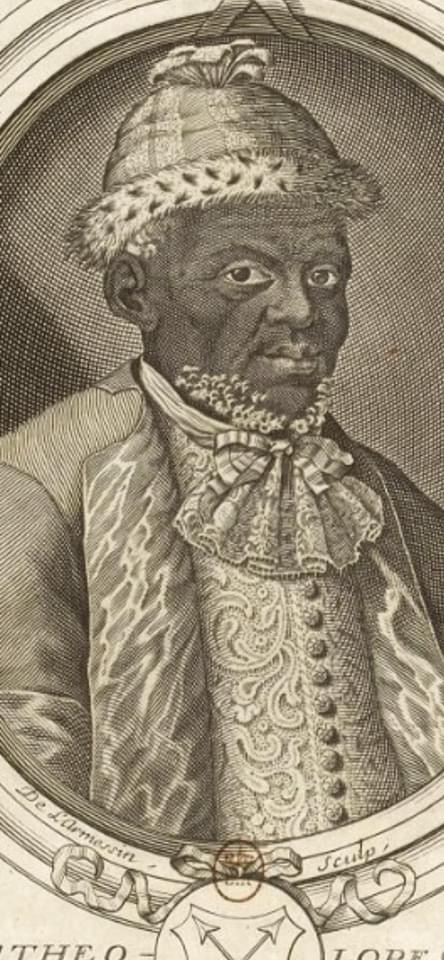


These portraits were engraved by Nicolas de Larmessin c. 1690…
Nicolas de Larmessin was a prominent French engraver and printmaker who lived during the late 17th and early 18th centuries…
Nicolas de Larmessin served as an engraver to King Louis XIV of France…
His position granted him access to the royal court and allowed him to create portraits and other works for the king and members of the French nobility…
Larmessin's engravings often depicted Louis XIV and other royal figures in a flattering and dignified manner…
“He [Louis XIV] also had a daughter who was not acknowledged...There was a nun in the Abbaye de Moret who was supposed to be his daughter. She was EXTREMELY SWARTHY, and otherwise resembled him”
SOURCE;
(Voltaire, “The Age of Louis XIV.: To which is Added, an Abstract of The Age of Louis XV”; 1780)
1780.
“Some people suspected, and not without reason, that a certain lady in the abbey of Moret was Louis's daughter. She was VERY BROWN, and resembled him in every other respect”
SOURCE;
(Thomas Pike Lathy, “Memoirs of the Court of Louis XIV. Comprising Biography and Anecdotes of the Most Celebrated Characters of that Period, Styled the Augustan Era of France. In Three Volumes.; 1819)
We are also told that the skin on his WELL PRESERVED corpse was as black as ink...
“Louis XIV was also in good preservation, but his skin was as BLACK as ink”
SOURCE;
(Sir Richard Phillips, "The Monthly Magazine" Vol.13; 1802)
To be clear, there is no question that Mummified skin can darken after being exposed to air...
But at the same time, as relates to the level of darkness: where you end up, is dependent on where you began....
3 notes
·
View notes